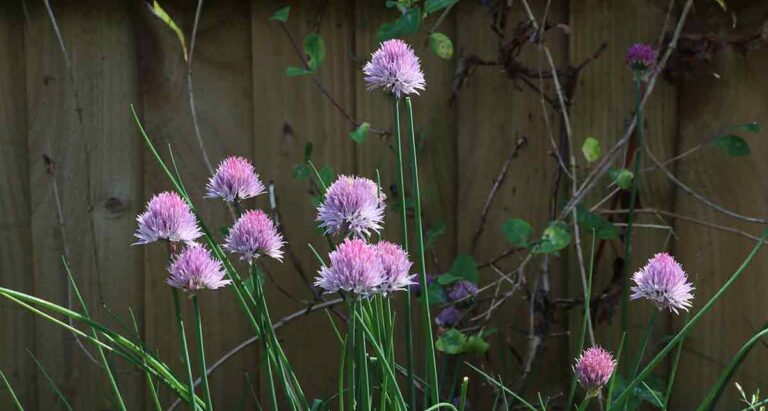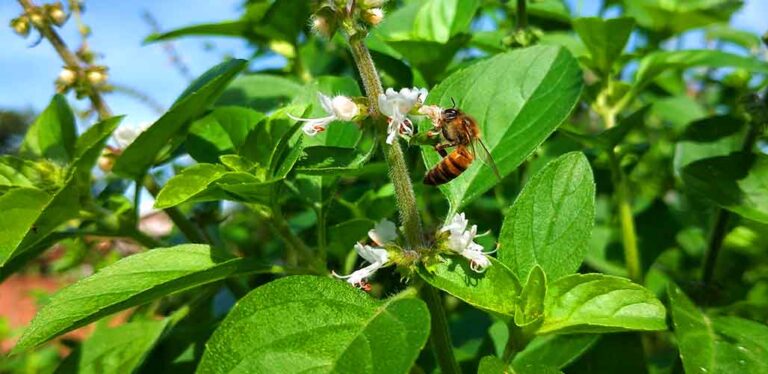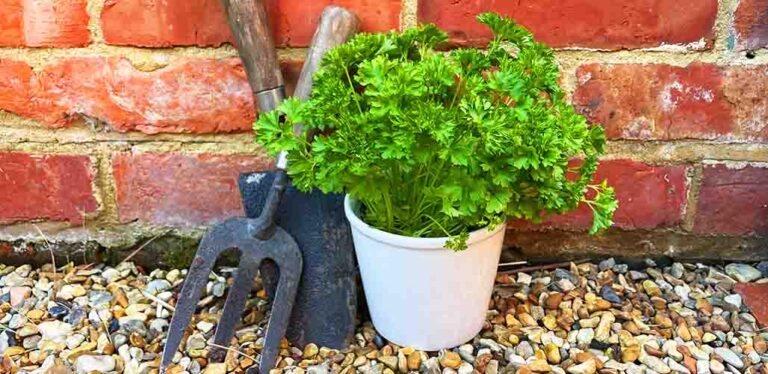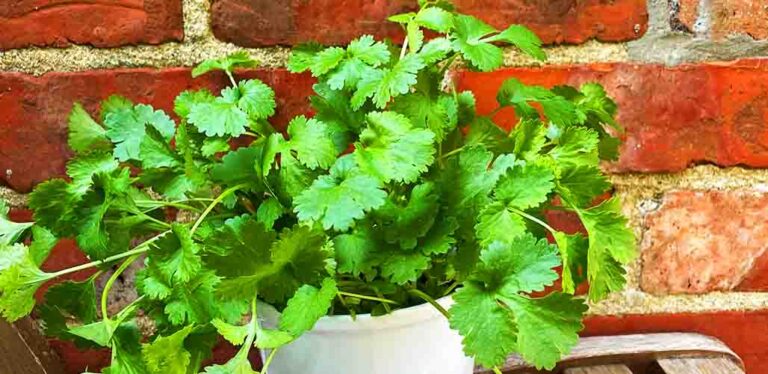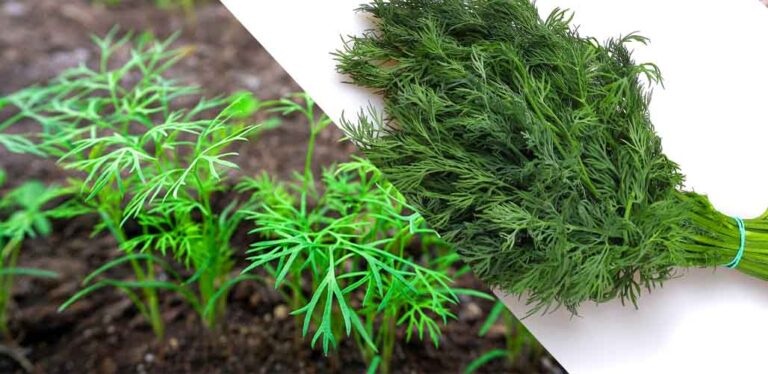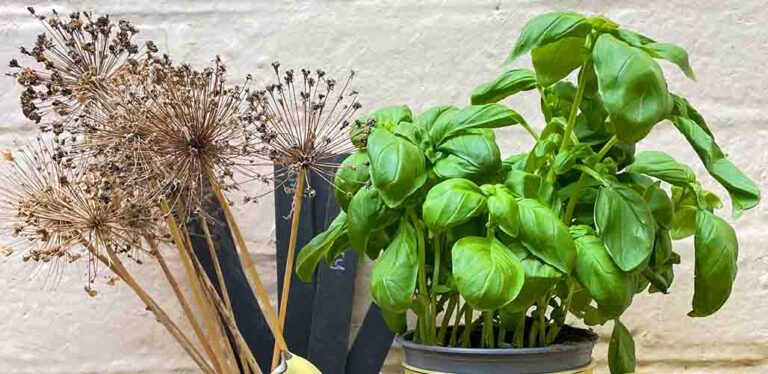What Herbs To Plant With Basil
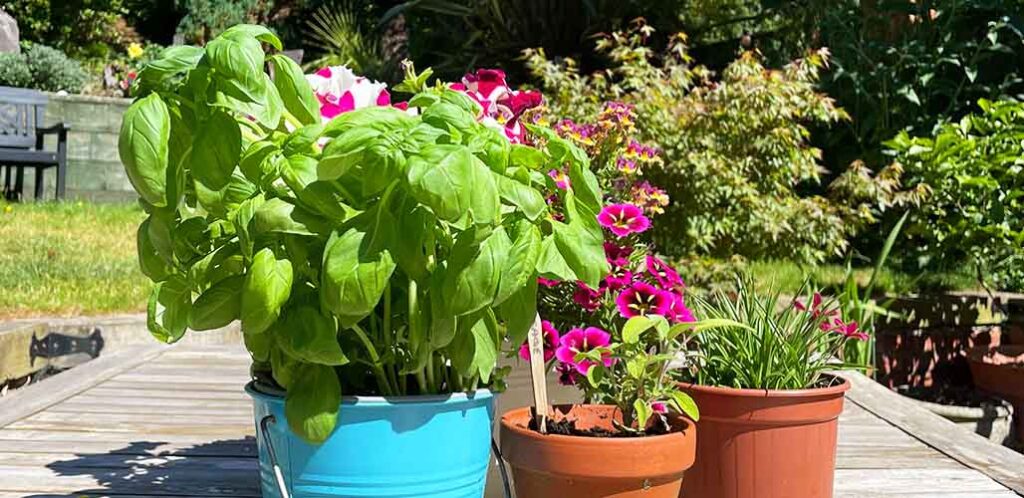
A container full of herbs placed strategically close to your kitchen door is a great way to give your cooking that extra burst of flavor. And a variety of different herbs is not only a useful addition to your pantry but also an attractive garden feature.
Your herbs will be happiest sharing a pot, if you group them with others that have the same likes and dislikes. Companion planting can have additional benefits for your plants too, these will help us decide which herbs will make the best partners for your basil plants.
Contents
- Herbs to grow with basil
- Other companions for basil
- Flowers to grow with basil
- What plants to avoid planting with basil
- Basil planting tips
Basil is one of our favorite and most versatile culinary herbs. The basil family of plants is originally native to tropical Asia, and they’re a staple flavor in Thai curries. But these days the type of basil we’re most familiar with is sweet basil, and it’s closely associated with Italian food (in which it’s known as basilico) and Spanish cuisine (where it’s called the albahaca plant).
Unsurprisingly given its origins, basil needs warmth and sunshine to grow. Most of us grow a new clutch of plants from seed each spring, either on a sunny window sill, or in a greenhouse. Basil particularly lends itself to being grown in a pot, so once night time temperatures in summer are consistently above 50f, their pots can be moved to a sunny outside spot if you like.
Here are our favorite herbs to plant with basil:
1. Chamomile
Chamomile tea made with fresh chamomile flowers is a delicious treat (and that’s coming from someone who doesn’t normally enjoy chamomile tea!) This fragrant herb is an annual just like basil, and it will tolerate a relatively broad temperature range. So just keep your chamomile and basil pot wherever the basil needs to be! Chamomile will keep flowering for as long as you keep picking from it, so harvest flowerheads regularly and dry any you won’t use right away. Choose Roman chamomile over German chamomile as a companion plant for basil – their heights are better matched.
2. Cilantro
Cilantro is another annual herb which thrives in a sunny spot where it won’t be battered by wind, left to dry out, or sat with its roots in water. A pot of basil alongside a pot of cilantro on a kitchen windowsill is one of the easiest ways to make all of your summer meals more exciting. For maximum impact, add our next herb too!
3. Parsley
You know those sets of three plant pots in a tray, that you can find in practically every homeware store? They were made for basil, cilantro and parsley to live side by side in. This trio is a great example of herbs that grow well together. They like the same amount of sun, they need watering at the same time, they all love nitrogen rich fertilizers for producing strong bushy foliage. Get them all, treat them like identical triplets, and make all your meals taste divine.
4. Dill
Does cilantro taste soapy to you? Or does parsley go uncropped in your kitchen? Swap out either one for dill instead. Dwarf dills are great companion plants for basil. Their delicate leaves have a mild fennel flavor, and the tiny yellow flowers are a pretty and edible addition to salads too.
5. Perilla
Perilla is an exciting option for anyone interested in growing something a little bit different. It’s actually closely related to basil – they are both members of the Lamiaceae plant family, along with mint. Originally from China, it’s a popular herb in Korean and Japanese cooking. Perilla plants are similar in size to basil and like the same conditions, so they very happily cohabit a pot together!
6. More basils!
Yes really! You’re probably best acquainted with sweet basil, but did you know that there are dozens of different varieties? Why not fill a large pot with several, and use them to experiment in your cooking:
- Purple basil. Use purple basils just like sweet basil – the deep purple leaves are a show stopping garnish on salads and antipasti boards. The plant is exceptionally ornamental too – great for a small space which needs to be beautiful and productive.
- Greek basil. Greek basil is a dwarf species: it is more compact and has much smaller leaves than sweet basil, and an intense flavor of aniseed and cloves. Use it in all the same ways as sweet basil.
- Lettuce leaf basil. Lettuce leaf basil grows crinkly leaves up to 6 inches long. Their flavor is ultra mild, so use them whole in salads.
- Thai basil. Thai basil is a staple of Thai and Asian cuisines, but it’s often hard to find outside of specialty food stores. Grow your own, and dust off those recipe books!
You could also swap out any one of those for red basil, lemon basil, cinnamon basil, or even mint basil!
Of course, you don’t have to be restricted to other herbs when it comes to companions for your basil plants. Basil is a great companion for a number of other popular plants
How companion planting works
Picking a companion for basil is a time-honored way of improving the health and productivity of your plants. Plants in nature are surrounded by other species, and replicating some of that variety in our own vegetable gardens can improve some plants’ growth, resilience to pests and diseases, productivity, and even flavor. Most of us would like a variety of things to look at and eat anyway, so knowing which companion plants will grow well together helps to make our plots and greenhouses diverse, attractive, and delicious!
In the purest sense, a companion plant protects another plant. The two ways one plant can protect another are
- By masking the scent of their protectee, so pests can’t find it.
- By attracting predators which eat the pests that target their protectee.
When companion planting works, it reduces the need for pesticides and increases yield. The companion plant can be something which is also edible or attractive in its own right, or it can be purely sacrificial.
How to choose basil companion plants
Companion plants for basil are usually chosen because of what basil can do for them, rather than the other way round! Basil’s delicious scent and flavor are the product of volatile organic compounds in their leaves and stem. And those compounds are really good at deterring insect pests!
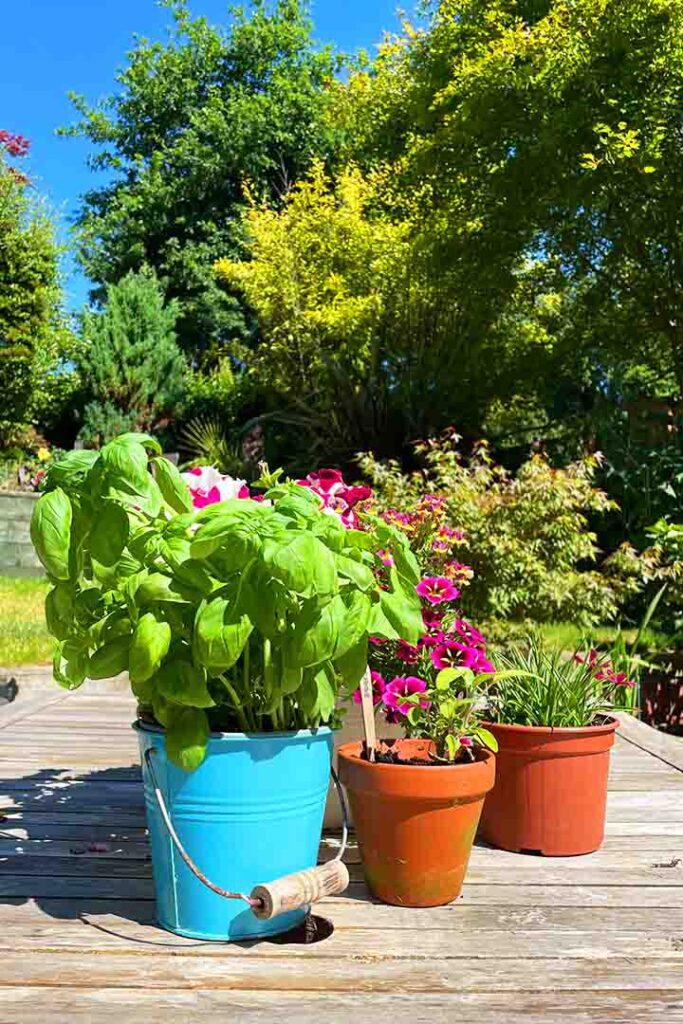
In a moment we’ll take a look at some of the plants which benefit from having a basil buddy nearby. But there are some other good reasons for seeking a companion plant for basil. Like needing complementary plants for a container display of herbs by your kitchen door.
Plants which grow happily alongside basil have closely matched needs in terms of light, soil type, watering, and space. You need to be sure that one won’t easily crowd out the other, too. Features of good basil companion plants to look for are:
- Annuals. Basil seeds are sown in spring, and ready to harvest 60 to 80 days later. In fall, they die off when temperatures start to dip below 50f again. The following spring, it’s time to start again. You can plant basil amongst perennials if you like (we’ve got a fun example of that coming up), but teaming them with other annuals offers versatility, and makes it easier to tip the whole lot out at the end of the season.
- Plants that like a lot of sun. Basil likes at least 6 hours of full sun a day.This can be too much for other species.
- Plants that like moist, well-drained soil. Basil loves soil which holds moisture without drying out too fast, but hates standing with its feet in a puddle. This limits which herbs it can live with, since Mediterranean herbs like thyme, rosemary and sage all love dry conditions.
- Equally vigorous plants. Plants in the same pots, or planted close to each other, will compete for light, water and nutrients. Mint is closely related to basil and likes similar conditions, but it’s also a thug and will crowd basil out of a pot.
What are good companion plants for basil?
Here are 13 plants we’ve chosen because they are the best companions for basil. There are some veg, some other herbs, and even a couple of flowers!
1. Tomatoes
Basil and tomatoes are one of the all time hero combinations in companion planting. Planting basil alongside tomatoes outside or in a greenhouse repels flies, aphids, mites, thrips, and tomato hornworm. And studies indicate that this translates into bigger, tastier crops.
‘Tastier?? But how can that be?’ you cry… Well gardeners have sworn it for years, and recently researchers have used chemical analysis to reveal one part of the puzzle. Tomatoes grown alongside basil have more of a compound called shikimic acid in their shoots. Exactly why isn’t fully understood yet, but shikimic acid is a precursor to the soluble sugars and lycopene in tomatoes which give them their flavor. For maximum effect, give each of your tomato plants its own basil buddy, and make sure they’re within 50cm of each other.
2. Peppers
Planting basil alongside sweet peppers reduces aphid damage. It works because the volatile organic compounds in basil disrupt female aphid behavior, and decrease how many eggs they lay. Basil and peppers are both well suited to growing in containers, in an unheated greenhouse. Basil’s protective effect over peppers is lost if the basil is allowed to flower, so pinch out the tops of stems regularly.
3. Chillies
Chillies and sweet peppers are closely related members of the capsicum family, so it’s no surprise that basil is a friend of chillies too. Many chillies are perennials which will fruit for several years if they’re protected from frost over winter. So keep your basil and your chillies in separate pots next to each other, to make it easier to discard the basil without disturbing the chillies.
4. Asparagus
Basil and asparagus both like moist but not waterlogged soil, and lots of sunshine. So they’re natural botanical buddies. Asparagus plants are perennial, and each crown can produce a crop of tasty spears in spring for 20 years or more. But, they have a very shallow root system, which means keeping their soil free from weeds is a notorious chore – weeding should always be done by hand rather than using a hoe. Growing basil around asparagus is a great way to suppress weeds with a tasty cropping plant instead. If you can time it right by starting basil indoors early in the season, the aroma from their leaves may protect the emerging asparagus stems from being nibbled by aphids too! In fall, cut back the basil to the ground at the same time as the asparagus fronds, and mulch over the whole lot with compost.
5. Onions
Onions are a friend to most plants. Their odorous leaves are highly effective at driving away pests, so planting basil amongst your onions could be just the solution if it’s actually your basil which needs a little protection. Sow a line of basil seeds between your onion rows and thin the seedlings out to 6 inches apart once they’re up. Summer onion sets go in the ground around March and are ready to lift in August. So a catch crop of basil seeds sown in May or June could mature in time to produce a month or more of leaves before it’s time to lift the onions. Or get a longer harvest by starting the basil indoors and planting out hardened off seedlings among your onions in June. This companion pairing is best suited to raised beds, so you can weed among your plants without stooping.
If you’re looking for something ornamental to bring a touch of pretty to your herb garden, these two flowers are great growing companions for basil.
1. Calendula
Calendula, or pot marigold, is a perfect pal for basil. Bright orange calendula flowers are exciting and tropical pops of color in summer. They can be used to make soaps and oils for moisturizing dry skin, and they’re edible too. Why not plant up a patio container with a bushy cherry tomato, a sweet basil, and a calendula? You’ll be using it all summer long to rustle up sweet and fragrant salads, decorated with pretty petals scattered on top for Insta-worthy photos.
2. Lemon scented pelargoniums
Last but not least, basils are great plants to team up with lemon scented pelargoniums (also known as tender geraniums) , to see off mosquitoes on summer evenings. Dot pots of each by doorways and next to outdoor seating, so that when people brush against them they release wafts of volatile organic compounds into the air, and repel those pesky bugs.
Two plants to keep away from basil
Basil is a friend to many, but there are two plants to keep them well away from. The first is lettuce. Lettuces bolt (put up flowerheads and attempt to make seeds, spoiling the harvestable plant) when they’re kept is as much heat and sunshine as basil needs. And the second is cucumber. Cucumbers tend to absorb the flavor of things growing around them, and those volatile organic compounds in basil are classic culprits for spoiling a cucumber.
Top tips for planting basil with other plants
- The main pests of basil are slugs and snails. Dress the top of their pot with sharp gravel, crushed shells or dry holly leaves to send these slimy gastropods packing.
- Feed basil with a high nitrogen fertilizer, to encourage lots of strong foliage. Tomatoes, peppers and chillies prefer a potassium rich fertilizer to promote fruit development, which is another reason why their friendship works best if they each keep their own place.
- Pinch out the growing tips of your basil plants to encourage bushy growth.
- Water them evenly. Basil plants sugar in both dry and waterlogged soils, which makes them vulnerable to diseases like powdery mildew. Water them from the bottom on a regular schedule, to keep them happy.
What to plant with basil – summary
Planting basil alongside other herbs, veg, or flowing plants adds diversity and interest to your garden, and can even improve how well both plants grow. In this guide we’ve looked a some of the science behind tried and tested companion plants for basil. The plants on our list are a great place to start, if you’re new to gardening. But don’t be afraid to try some ideas of your own. The great thing about annuals like basil is that even if something doesn’t work out, you can just try again next year!
If you’ve planted basil this year, what plants have you chosen to keep it company? Let us know in the comments box down below!
You might also enjoy
- Tomato Plant Leaves Turning White
- When To Transplant Tomato Seedlings
- How To Harvest Cilantro Without Killing The Plant
- Why Are My Cucumber Leaves Turning Yellow?
- Comparing coconut and cedar mulch
References
- Ahmad. Changes in Secondary Metabolites and Free Amino Acid Content in Tomato with Lamiaceae Herbs Companion Planting. American Journal of Plant Sciences. 2020.
- Farrell. The Kew Gardener’s Guide To Growing Herbs. White Lion. 2019.
- Issa et al. Influence of neighbouring companion plants on the performance of aphid populations on sweet pepper plants under greenhouse conditions. Agricultural and Forest Entomology. 2016.
- Marshall. The Greenhouse Gardener’s Manual. Timber Press. 2014.
- Royal Horticultural Society.

